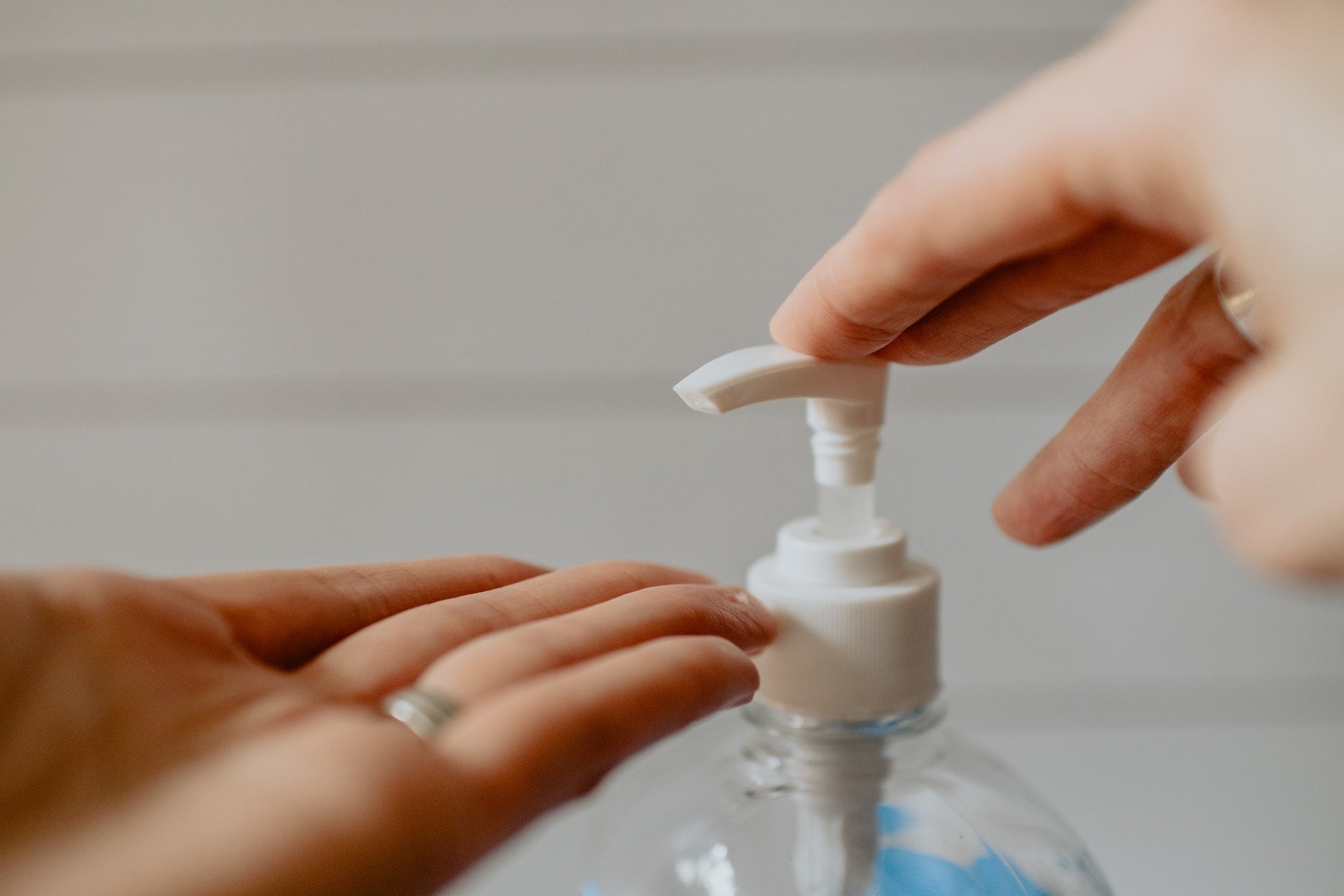
How to Clean Hand Sanitizer Stains on Different Fabrics
A hand sanitizer does not really stain clothes, but it does cause discoloration. This is especially true for dark-colored clothing, leather, suede, chiffon, and silk. The bleaching property of the sanitizer causes the discoloration. It can alter the fabric’s color on the spots where a hand sanitizer is set on.
Kinds of Hand Sanitizers and Their Bleaching Powers

There are two main types of hand sanitizer: alcohol-based and non-alcohol-based.
Alcohol-based hand sanitizers are more effective at killing germs, but they are also more likely to cause discoloration. Non-alcohol-based hand sanitizers are less likely to cause discoloration. But they are also less effective at killing germs.
What’s in a Hand Sanitizer That Causes Stains?

The following ingredients in your favorite sanitizer can cause some form of discoloration. Look for them on the label before buying:
- Alcohol is a solvent that can dissolve the dye in fabrics. This is why alcohol-based sanitizers are more likely to cause discoloration than non-alcohol-based sanitizers.
- Benzalkonium chloride is a disinfectant that can also act as a bleaching agent. This means that it can remove the color from fabrics.
- Hydrogen peroxide is a mild bleaching agent that’s useful during cleaning processes. It’s the ingredient in the sanitizer that may alter the color of fabrics.
- Triclosan is an antimicrobial agent that can also act as a bleaching agent. A report says there is a likelihood that 75% of Americans are exposed to this ingredient on a regular basis.
In addition to the ingredients above, other ingredients in hand sanitizer, such as fragrances and dyes, can also potentially cause staining or discoloration. However, the ingredients listed above are the most common culprits.
If you like sanitizers with “beads”, which are typically made of glycerin, it can be a non-staining ingredient. Remember, no type of hand sanitizer is completely guaranteed to be stain-free.
Fabrics Prone to Hand Sanitizer Stains

There are fabrics that should not touch sanitizers because they’re sure to be stained or discolored.
The following materials are more prone to stains:
- Darker colored clothing contains more dye than light-colored fabrics. The alcohol and other bleaching ingredients in a sanitizer can cause discoloration.
- Leather is a natural material that is susceptible to damage from chemicals. The alcohol and other bleaching ingredients in hand sanitizer can dry out the leather and cause it to crack and fade.
- Suede is a delicate fabric that is easily damaged by moisture. The alcohol in hand sanitizer can cause suede to shrink and become discolored.
- Chiffon is a sheer fabric that is made from delicate fibers. The alcohol in the sanitizer can dissolve these fibers, causing the fabric to become weak and tear easily.
- Silk is a natural fiber that is susceptible to damage from chemicals. Hand sanitizers can remove the color from silk and cause it to become brittle.
In addition to the materials listed above, other materials, such as wool, nylon, and polyester, can also be stained by hand sanitizer. However, the materials listed above are the most susceptible.
How to Remove Hand Sanitizer Stains

Hand sanitizer can be an effective tool for keeping your hands clean and germ-free. However, it can also be a pain to remove if it gets on your clothes or other fabrics.
If you do get it on your clothes or other fabrics, it's important to act quickly. The longer the stain sits, the harder it will be to remove.
The best way to remove hand sanitizer stains is with a natural laundry stain remover that works wonders on all types of fabrics. It works well without damaging the fabric itself.
Here are some other ways to remove those stains from different types of materials or fabrics:
Dark-colored clothing
What you need: clean cloth, distilled vinegar, laundry detergent
- Gently scrape off as much of the hand sanitizer as possible with a clean cloth.
- Mix equal parts white vinegar and laundry detergent in a bowl.
- Apply the mixture to the stain with a laundry brush.
- Let the mixture sit on the stain for 30 minutes.
- Rinse the stain with cold water.
- Wash the garment as usual.
Leather
- What you need: clean cloth and mild soap
- Gently scrape off as much of the hand sanitizer as possible with a clean cloth.
- Mix a small amount of mild soap with water.
- Apply the soapy water to the stain with a soft cloth.
- Wipe the stain clean with a damp cloth.
- Allow the leather to dry completely.
Suede
What you need: suede brush and suede eraser
- Brush the stain in the direction of the nap with a soft brush.
- Use a suede eraser to gently rub the stain.
- Brush the area again in the direction of the nap.
Chiffon
What you need: mild liquid soap or hand soap and a clean cloth
- Gently scrape off as much of the hand sanitizer as possible with a clean cloth.
- Mix a small amount of mild soap with water.
- Apply the soapy water to the stain with a soft cloth.
- Rinse the stain with cold water.
- Allow the chiffon to dry completely.
Silk
What you need: mild liquid soap or hand soap and a clean cloth
- Gently scrape off as much of the hand sanitizer as possible with a clean cloth.
- Mix a small amount of mild liquid soap with water.
- Apply the soapy water to the stain with a soft cloth.
- Rinse the stain with cold water.
- Allow the silk to dry completely.
It's important to note that some materials, such as wool, may be more susceptible to damage from hand sanitizer. If you're not sure how to remove a hand sanitizer stain from a particular material, it's always best to consult a professional cleaner.
Frequently Asked Questions (FAQs)

Does hand sanitizer stain permanently?
Most hand sanitizer stains can be removed if treated promptly. However, if the stain is allowed to set in, it may be more difficult or impossible to remove.
How to get hand sanitizer stains on denim or jeans?
To remove sanitizer stains from denim or jeans, follow the instructions for removing or cleaning them from darker-colored clothing.
Scrape off the hand sanitizer, then spray on or apply a vinegar and laundry detergent mixture on the stain. Let it sit for 30 minutes, then rinse with cold water.
Will rinsing off hand sanitizer immediately prevent staining?
Rinsing it off immediately can help to reduce the risk of staining, but it is not guaranteed to prevent it completely.
How to avoid hand sanitizer stains?
The best way to avoid hand sanitizer stains is to be careful when applying it on your hands. Avoid getting it on your clothes, especially if you are wearing dark-colored clothing or clothing made of delicate materials. If you do get the liquid on your clothes, blot it up immediately with a clean cloth.
Tackle Hand Sanitizer Stains with Enzymatic Cleaners

Hand sanitizer, along with proper hand washing, can be effective for keeping your hands clean and germ-free. However, it can also cause discoloration of fabrics, especially dark-colored clothing, leather, suede, chiffon, and silk. The bleaching ingredients are responsible for this discoloration.
Alcohol-based hand sanitizers are more likely to cause discoloration than non-alcohol-based hand sanitizers. If you do get it on your clothes, act quickly using the steps mentioned above and keep an enzyme-based stain remover handy to tackle tough spots.

























